ECU FORD ESCORT 1998 7.G Owners Manual
[x] Cancel search | Manufacturer: FORD, Model Year: 1998, Model line: ESCORT, Model: FORD ESCORT 1998 7.GPages: 191, PDF Size: 1.51 MB
Page 8 of 191

position to check the bulb. If it
comes on after the engine is
started, one of the engine's
emission control systems may be
malfunctioning. The light may
illuminate without a driveability
concern being noted. The vehicle
will usually be drivable and will not
require towing.
What you should do if the
Service Engine Soon light
illuminates
Light turns on solid:
This means that the OBD II system
has detected a malfunction.
Temporary malfunctions may cause
yourService Engine Soonlight to
illuminate. Examples are:
1. The vehicle has run out of fuel.
(The engine may misfire or run
poorly.)
2. Poor fuel quality or water in the
fuel.
3. The fuel cap may not have been
properly installed and securely
tightened.
These temporary malfunctions can
be corrected by filling the fuel tank
with good quality fuel and/or
properly installing and securely
tightening the gas cap. After three
driving cycles without these or any
other temporary malfunctions
present, theService Engine Soon
light should turn off. (A driving
cycle consists of a cold engine
startup followed by mixed
city/highway driving.) No
Instrumentation
8
Page 50 of 191
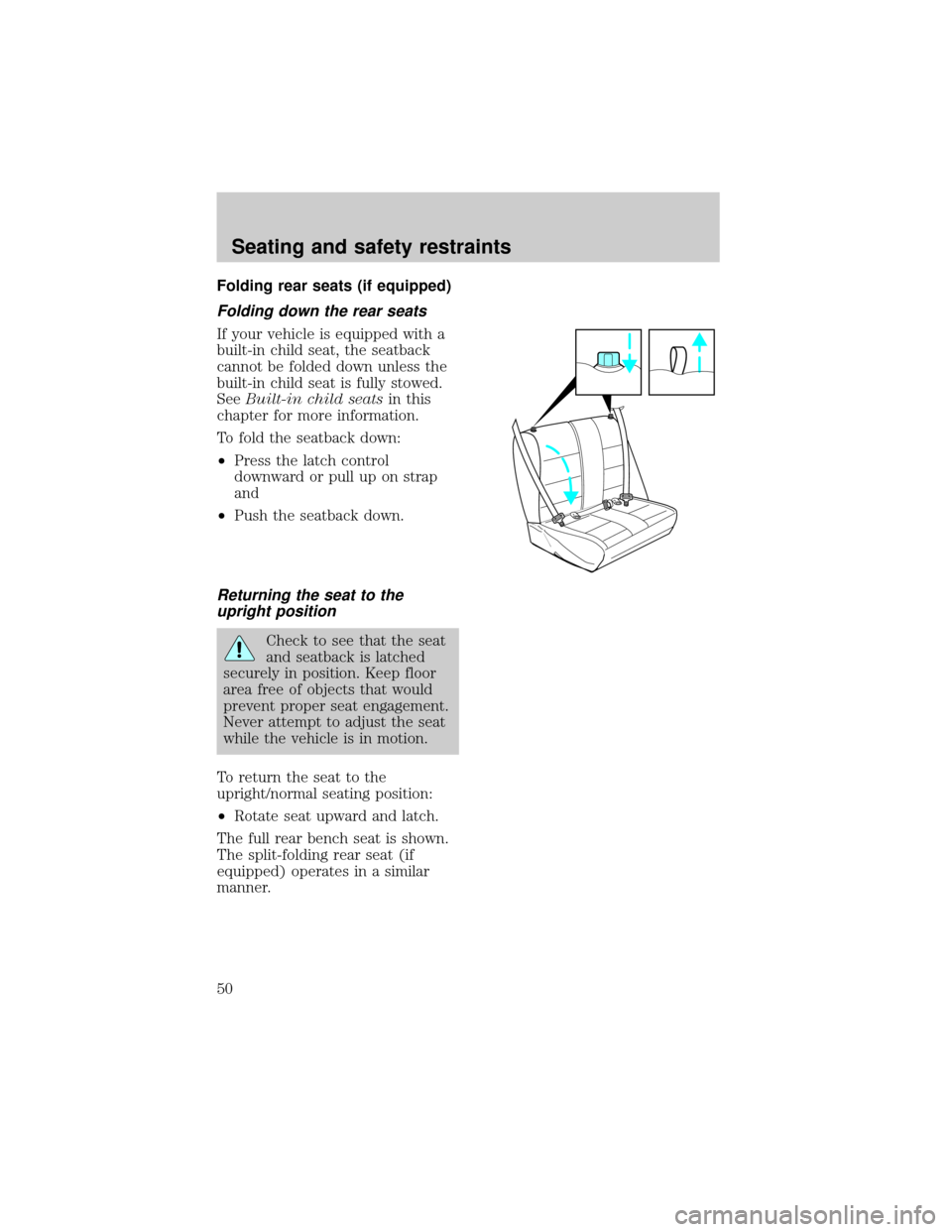
Folding rear seats (if equipped)
Folding down the rear seats
If your vehicle is equipped with a
built-in child seat, the seatback
cannot be folded down unless the
built-in child seat is fully stowed.
SeeBuilt-in child seatsin this
chapter for more information.
To fold the seatback down:
²Press the latch control
downward or pull up on strap
and
²Push the seatback down.
Returning the seat to the
upright position
Check to see that the seat
and seatback is latched
securely in position. Keep floor
area free of objects that would
prevent proper seat engagement.
Never attempt to adjust the seat
while the vehicle is in motion.
To return the seat to the
upright/normal seating position:
²Rotate seat upward and latch.
The full rear bench seat is shown.
The split-folding rear seat (if
equipped) operates in a similar
manner.
Seating and safety restraints
50
Page 66 of 191
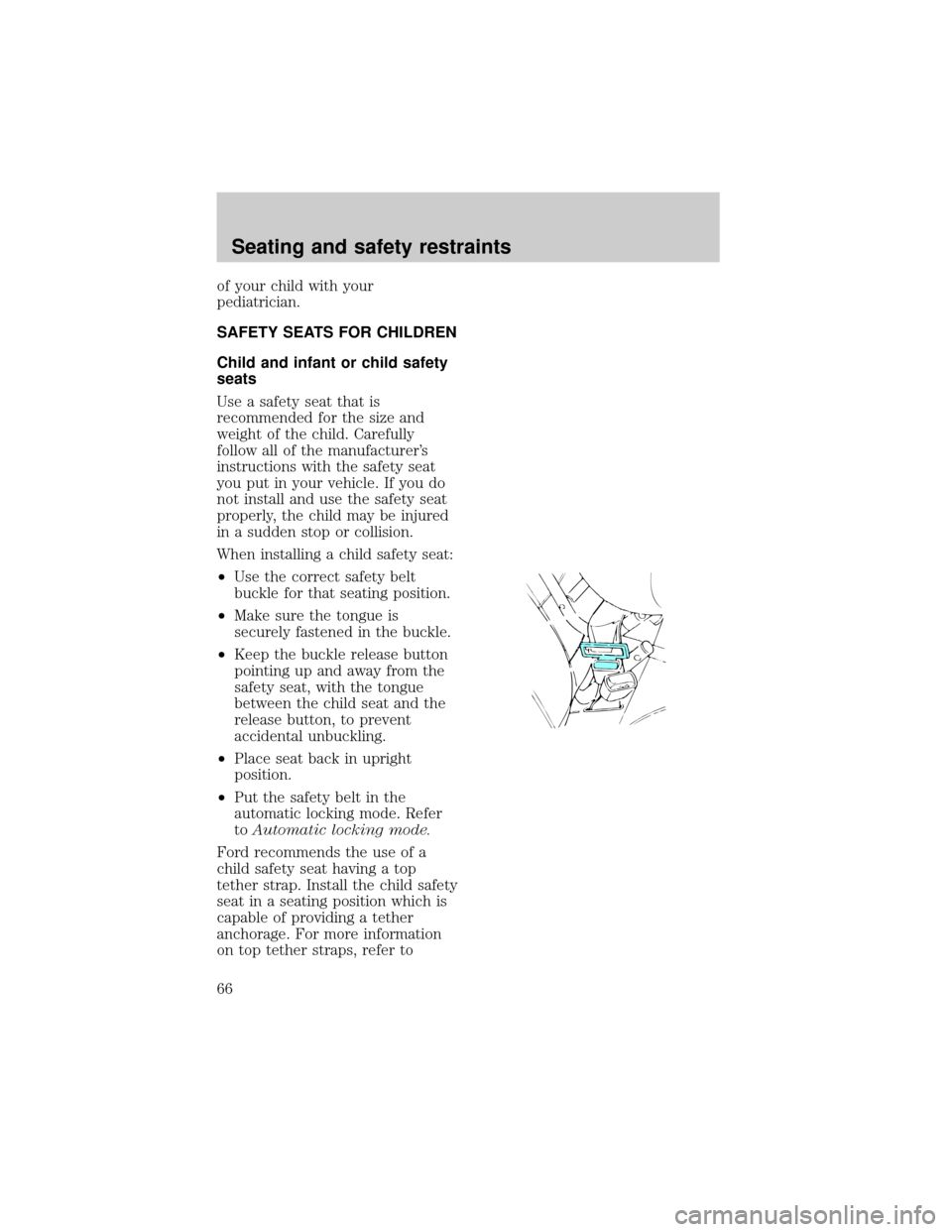
of your child with your
pediatrician.
SAFETY SEATS FOR CHILDREN
Child and infant or child safety
seats
Use a safety seat that is
recommended for the size and
weight of the child. Carefully
follow all of the manufacturer's
instructions with the safety seat
you put in your vehicle. If you do
not install and use the safety seat
properly, the child may be injured
in a sudden stop or collision.
When installing a child safety seat:
²Use the correct safety belt
buckle for that seating position.
²Make sure the tongue is
securely fastened in the buckle.
²Keep the buckle release button
pointing up and away from the
safety seat, with the tongue
between the child seat and the
release button, to prevent
accidental unbuckling.
²Place seat back in upright
position.
²Put the safety belt in the
automatic locking mode. Refer
toAutomatic locking mode.
Ford recommends the use of a
child safety seat having a top
tether strap. Install the child safety
seat in a seating position which is
capable of providing a tether
anchorage. For more information
on top tether straps, refer to
Seating and safety restraints
66
Page 68 of 191
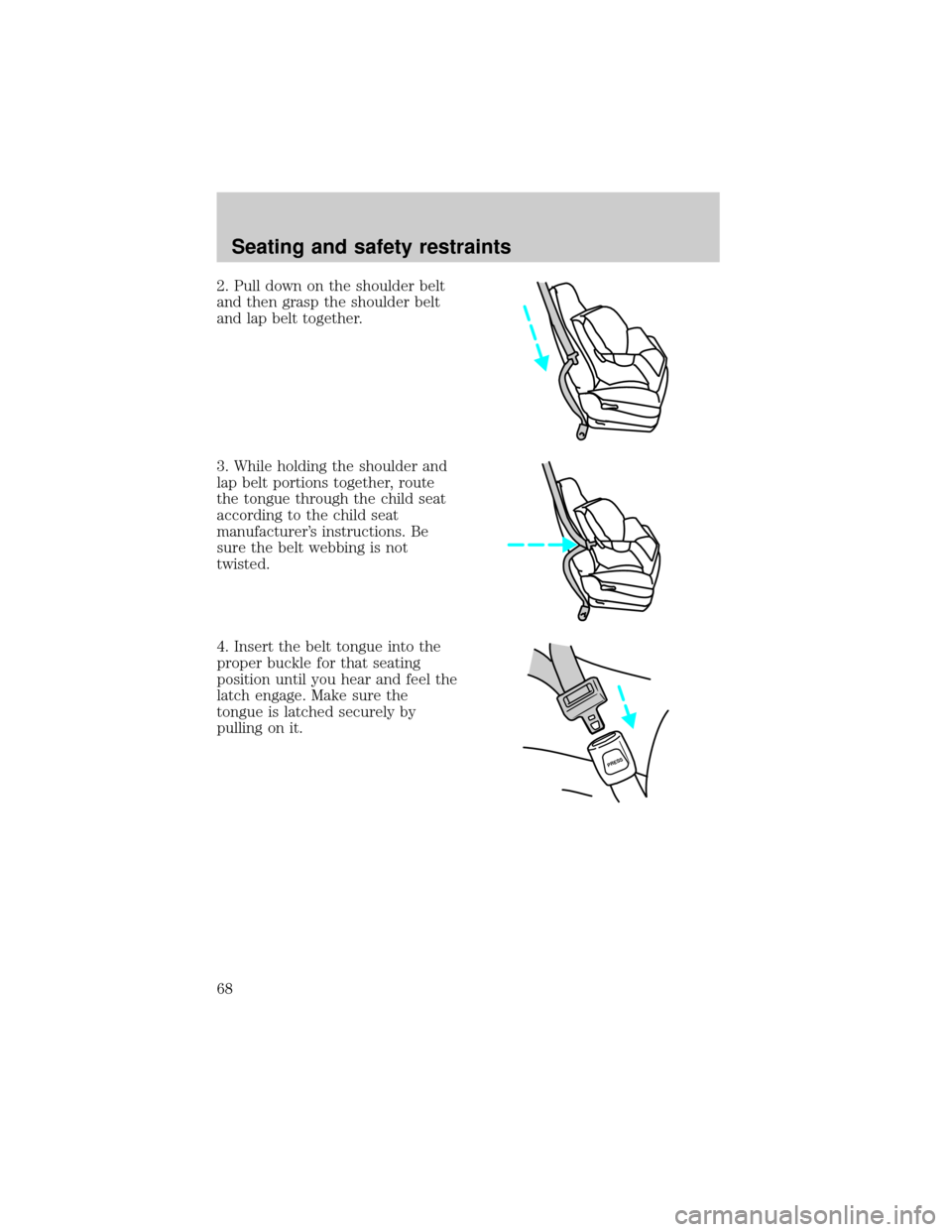
2. Pull down on the shoulder belt
and then grasp the shoulder belt
and lap belt together.
3. While holding the shoulder and
lap belt portions together, route
the tongue through the child seat
according to the child seat
manufacturer's instructions. Be
sure the belt webbing is not
twisted.
4. Insert the belt tongue into the
proper buckle for that seating
position until you hear and feel the
latch engage. Make sure the
tongue is latched securely by
pulling on it.
PRESS
Seating and safety restraints
68
Page 69 of 191
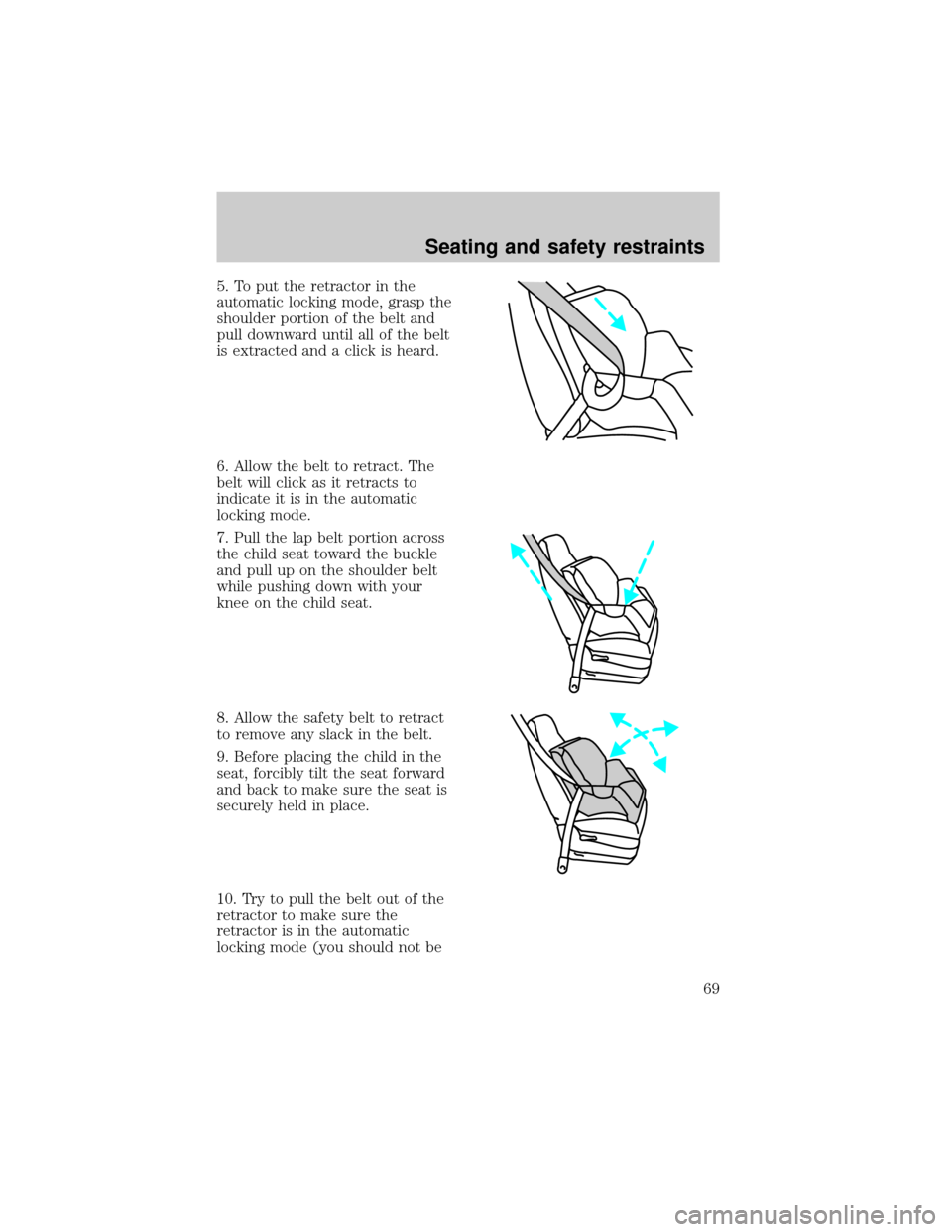
5. To put the retractor in the
automatic locking mode, grasp the
shoulder portion of the belt and
pull downward until all of the belt
is extracted and a click is heard.
6. Allow the belt to retract. The
belt will click as it retracts to
indicate it is in the automatic
locking mode.
7. Pull the lap belt portion across
the child seat toward the buckle
and pull up on the shoulder belt
while pushing down with your
knee on the child seat.
8. Allow the safety belt to retract
to remove any slack in the belt.
9. Before placing the child in the
seat, forcibly tilt the seat forward
and back to make sure the seat is
securely held in place.
10. Try to pull the belt out of the
retractor to make sure the
retractor is in the automatic
locking mode (you should not be
Seating and safety restraints
69
Page 70 of 191
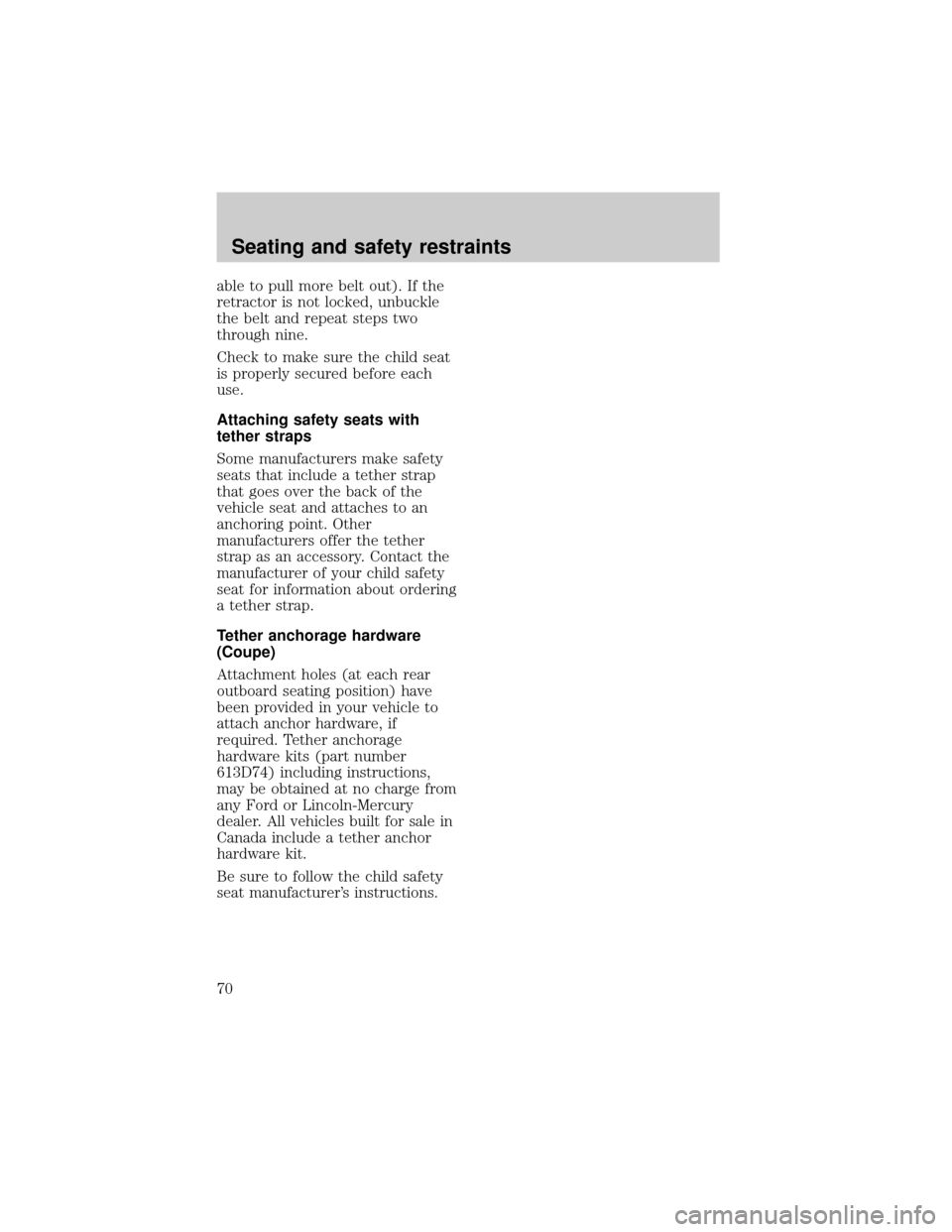
able to pull more belt out). If the
retractor is not locked, unbuckle
the belt and repeat steps two
through nine.
Check to make sure the child seat
is properly secured before each
use.
Attaching safety seats with
tether straps
Some manufacturers make safety
seats that include a tether strap
that goes over the back of the
vehicle seat and attaches to an
anchoring point. Other
manufacturers offer the tether
strap as an accessory. Contact the
manufacturer of your child safety
seat for information about ordering
a tether strap.
Tether anchorage hardware
(Coupe)
Attachment holes (at each rear
outboard seating position) have
been provided in your vehicle to
attach anchor hardware, if
required. Tether anchorage
hardware kits (part number
613D74) including instructions,
may be obtained at no charge from
any Ford or Lincoln-Mercury
dealer. All vehicles built for sale in
Canada include a tether anchor
hardware kit.
Be sure to follow the child safety
seat manufacturer's instructions.
Seating and safety restraints
70
Page 71 of 191

Tighten the anchor
according to specifications.
Otherwise, the safety seat may
not be properly secured and the
child may be injured in a sudden
stop or collision.
1. Install the child safety seat in
the rear right or rear left seat
position. For instructions on how
to install the seat, refer to
Installing child safety seats in
combination lap and shoulder
belt seating positionsin this
chapter.
2. Refer to the instructions
provided in the tether anchor kit.
3. Refer to the instructions
provided with your child safety
seat to securely attach the child
safety seat by tether to the tether
strap anchor location.
Tether anchorage hardware
(Sedan/Wagon)
Attachment holes (at each rear
seating position) have been
provided in your vehicle to attach
anchor hardware, if required.
Tether anchorage hardware kits
including instructions, may be
obtained at no charge from any
Ford or Lincoln-Mercury dealer. All
vehicles built for sale in Canada
include a tether anchor hardware
kit.
Be sure to follow the child safety
seat manufacturer's instructions.
Seating and safety restraints
71
Page 72 of 191
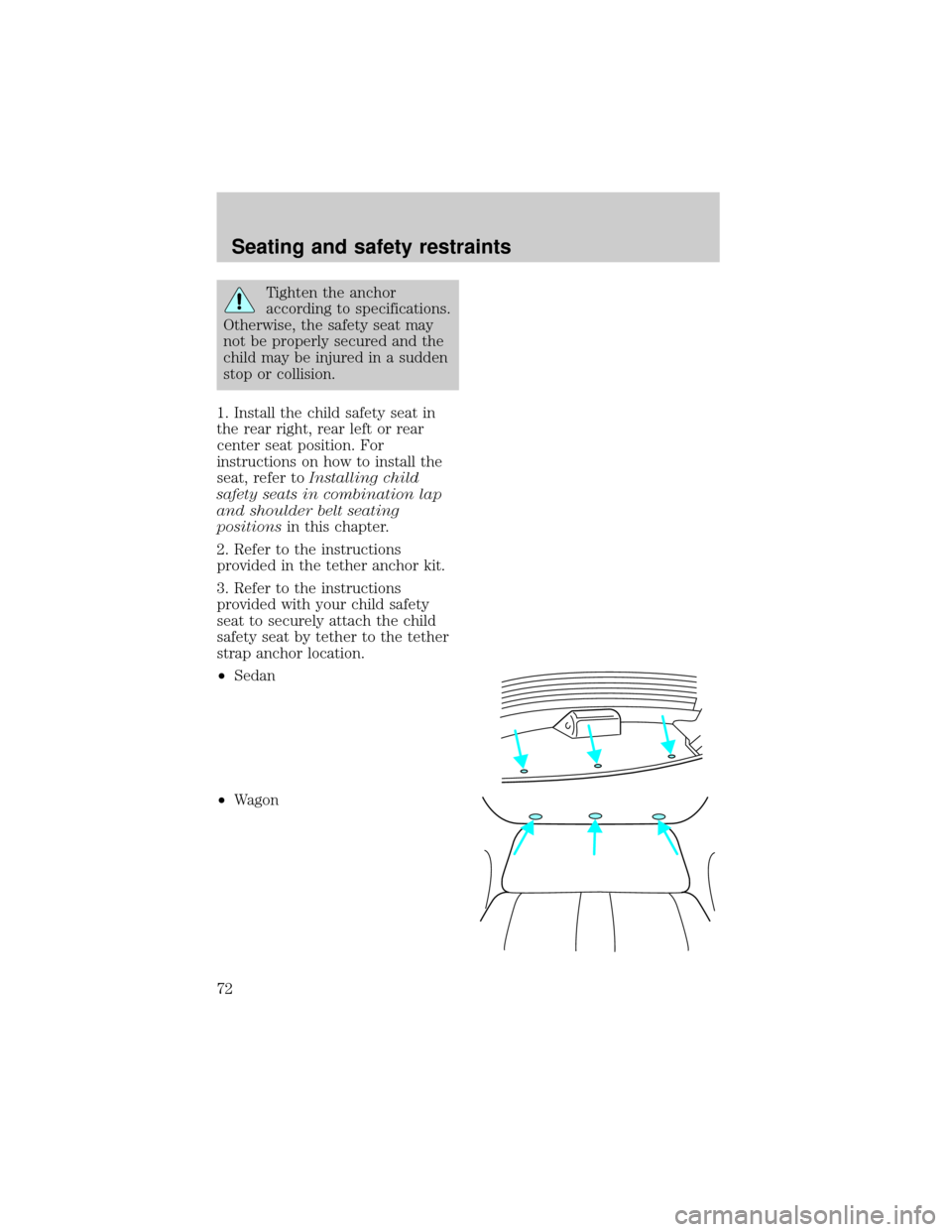
Tighten the anchor
according to specifications.
Otherwise, the safety seat may
not be properly secured and the
child may be injured in a sudden
stop or collision.
1. Install the child safety seat in
the rear right, rear left or rear
center seat position. For
instructions on how to install the
seat, refer toInstalling child
safety seats in combination lap
and shoulder belt seating
positionsin this chapter.
2. Refer to the instructions
provided in the tether anchor kit.
3. Refer to the instructions
provided with your child safety
seat to securely attach the child
safety seat by tether to the tether
strap anchor location.
²Sedan
²Wagon
Seating and safety restraints
72
Page 73 of 191
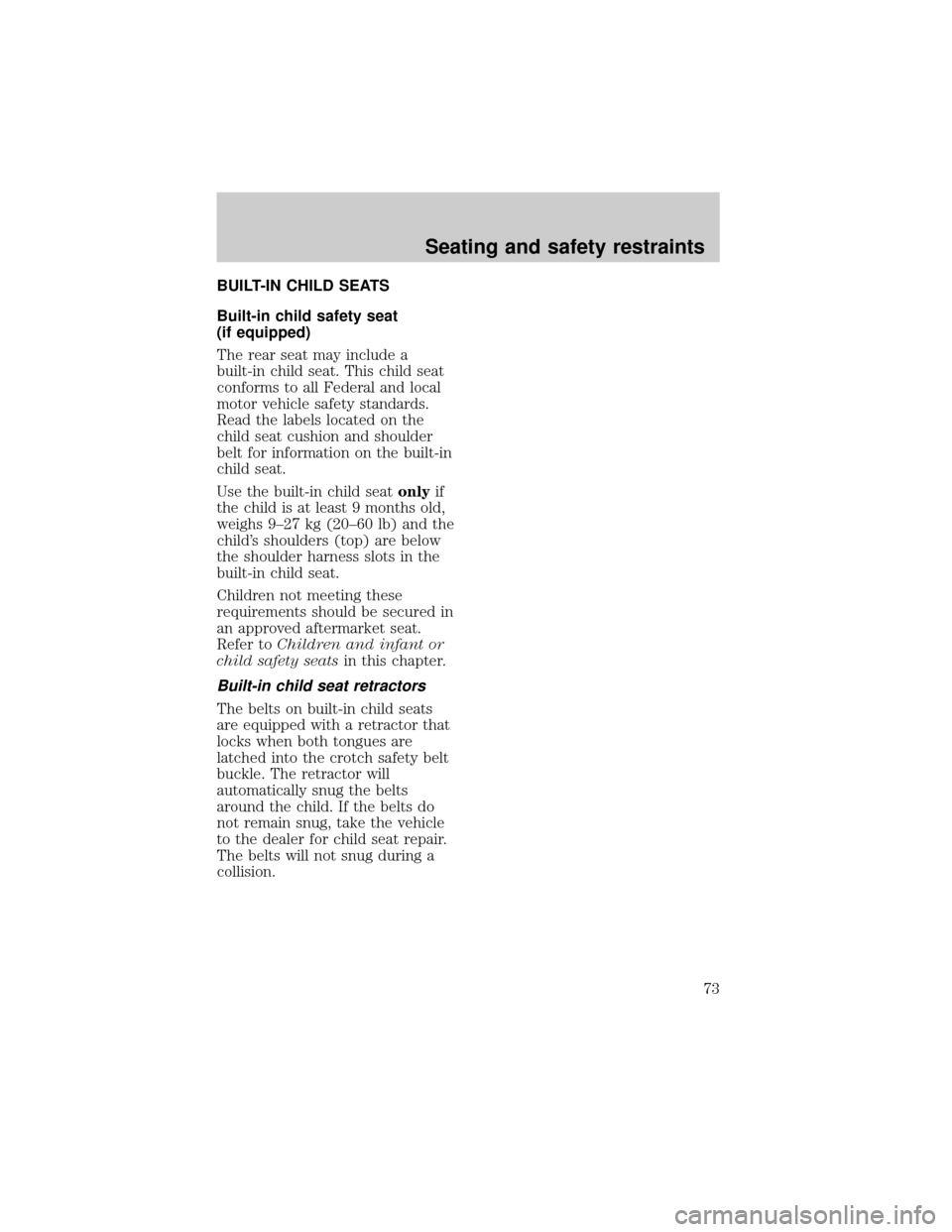
BUILT-IN CHILD SEATS
Built-in child safety seat
(if equipped)
The rear seat may include a
built-in child seat. This child seat
conforms to all Federal and local
motor vehicle safety standards.
Read the labels located on the
child seat cushion and shoulder
belt for information on the built-in
child seat.
Use the built-in child seatonlyif
the child is at least 9 months old,
weighs 9±27 kg (20±60 lb) and the
child's shoulders (top) are below
the shoulder harness slots in the
built-in child seat.
Children not meeting these
requirements should be secured in
an approved aftermarket seat.
Refer toChildren and infant or
child safety seatsin this chapter.
Built-in child seat retractors
The belts on built-in child seats
are equipped with a retractor that
locks when both tongues are
latched into the crotch safety belt
buckle. The retractor will
automatically snug the belts
around the child. If the belts do
not remain snug, take the vehicle
to the dealer for child seat repair.
The belts will not snug during a
collision.
Seating and safety restraints
73
Page 90 of 191
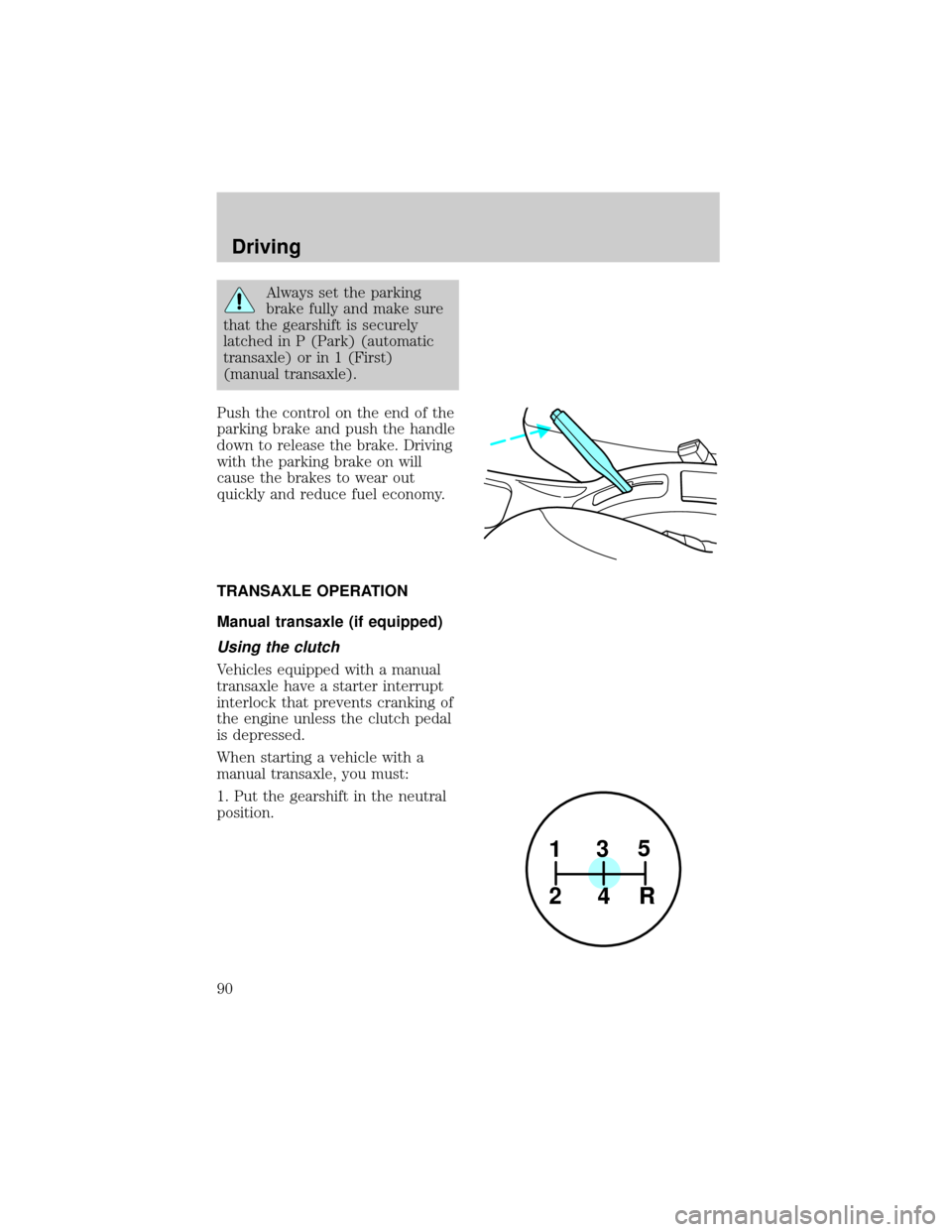
Always set the parking
brake fully and make sure
that the gearshift is securely
latched in P (Park) (automatic
transaxle) or in 1 (First)
(manual transaxle).
Push the control on the end of the
parking brake and push the handle
down to release the brake. Driving
with the parking brake on will
cause the brakes to wear out
quickly and reduce fuel economy.
TRANSAXLE OPERATION
Manual transaxle (if equipped)
Using the clutch
Vehicles equipped with a manual
transaxle have a starter interrupt
interlock that prevents cranking of
the engine unless the clutch pedal
is depressed.
When starting a vehicle with a
manual transaxle, you must:
1. Put the gearshift in the neutral
position.
1
24R35
Driving
90